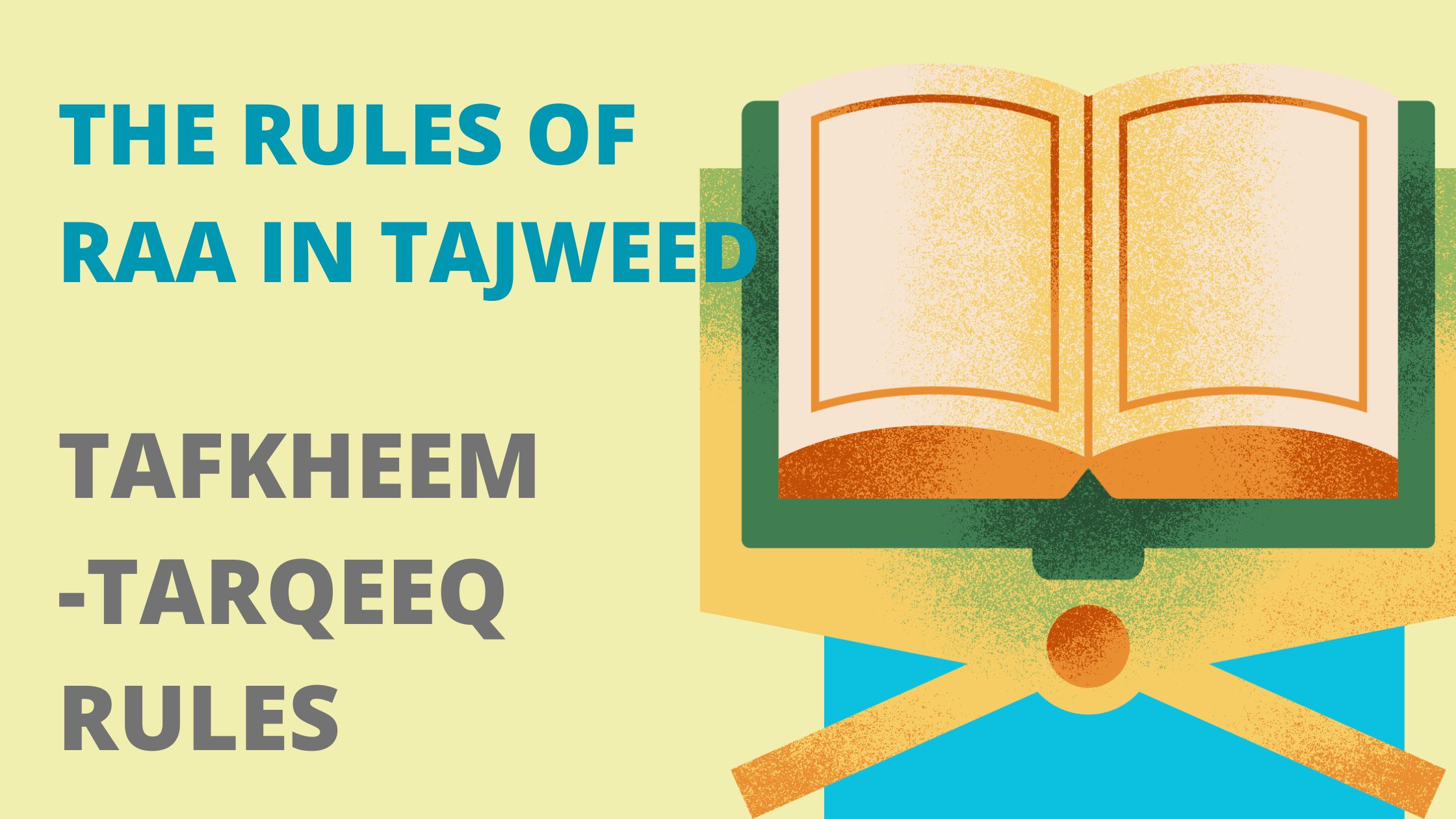In this blog post, we will explore the complex rules of Raa in Tajweed. As one of the most important letters in Tajweed, it is essential to understand its rules and pronunciation for proper recitation of the Quran.
Whether it is the Tafkheem/Tarqeeq rule based on the preceding vowel or the differentiation between heavy and light pronunciations, we will provide a detailed explanation of all the rules related to the letter Raa.
Table of Contents
Pronunciation of the Letter Raa in the Quran
The pronunciation of the letter Raa in the Quran is an essential aspect of Tajweed. Here are some key steps to understand to pronounce this unique letter correctly:
1. Positioning of the Tongue:
The tip of the tongue should be pressed firmly against the alveolar ridge, which is the area where the upper gums meet the front teeth. This creates a point of contact for the vibration of the tongue.
2. Vibration of the Tongue:
As the air is expelled from the mouth, the tip of the tongue vibrates against the alveolar ridge, producing the distinct “Raa” sound. This vibration is an important aspect of correctly pronouncing the Letter Raa in Tajweed.
3. Alveolar Ridge:
The alveolar ridge is a bony ridge located along the upper jawbone, just behind the upper front teeth. It serves as the point of contact for the tongue when pronouncing the Letter Raa. By placing the tongue in the correct position against the alveolar ridge, the proper sound can be achieved.
4. Avoiding Mistakes:
Proper placement of the tongue ensures accurate pronunciation of the Letter Raa and helps avoid any mistakes in Quranic recitation. It is important to practice and master this technique to ensure the correct pronunciation.
Take advantage of this opportunity to learn Noorani Qaida online and improve your Quranic recitation skills by visiting Bayan Al-Quran Academy today!
The Rules of Raa in Tajweed
The rules of Raa in Tajweed are essential for proper pronunciation when reciting the Quran. These rules help ensure that the letter Raa is pronounced correctly and with clarity. Below are some key rules to keep in mind:
1. Heavy Raa (Tafkheem Of Raa):
When the letter Raa (ر) is accompanied by a Harakah (diacritic) on top, such as Fatha or Damma, it is pronounced with a heavy voice. This means that the sound of the Raa is pronounced with more emphasis and intensity.
2. Light Raa (Tarqeeq Of Raa):
When the letter Raa (ر) is accompanied by a Harakah (diacritic) under it, such as Kasrah, it is pronounced with a light sound. This means that the sound of the Raa is pronounced with less intensity and emphasis.
3. Priority of Tarqeeq:
In some cases, the letter Raa can be pronounced with either Tafkheem or Tarqeeq, but the priority is given to Tarqeeq. This means that if there is a choice between pronouncing the Raa with a heavy or light sound, the preference is for the light sound.
4. Priority of Tafkheem:
However, there is one exception where the priority is given to Tafkheem. This occurs in only one word in the Quran, where the Raa is pronounced with a heavy sound even though it is accompanied by a Harakah under it.
Examples of Tarqeeq of Raa
Tarqeeq refers to the light pronunciation of the letter “Raa” in certain cases. There are main rules and examples of the Tarqeeq of Raa in Tajweed:
1. Tarqeeq of Raa when the Raa comes with Kasrah
In this case, when the letter Raa is followed by a kasrah, it is pronounced with tarqeeq. For example, in the word “رِزْقًا” (rizqan) where the Raa is followed by a kasrah, it is pronounced with tarqeeq.
2. Tarqeeq of Raa when it is followed by a Sukoon and preceded by a letter with Kasrah
When the letter Raa has a sukoon and is preceded by a letter with kasrah, it is also pronounced with tarqeeq. An example of this case is the word “وَاسْتَغْفِرْه” (wastaghfirhu), where the Raa has a sukoon and is preceded by the letter “fa” with kasrah.
3. Tarqeeq of Raa when the Raa comes with Sukoon and is preceded by Yaa Sakinah
In this case, when the Raa has a sukoon and is preceded by a Yaa Sakinah, it is pronounced with tarqeeq. For example, the word “الْخَـيْرِ” (al-khayri), where the Raa has a sukoon and is preceded by the Yaa Sakinah.
4. Tarqeeq of Raa when the Raa comes with Sukoon and is preceded by a Sakin letter and this letter is preceded by a letter with a Kasrah
When the Raa has a sukoon and is preceded by a sakin letter, which is in turn preceded by a letter with a kasrah, it is pronounced with tarqeeq. An example of this rule is the word “حِجْــــرٍ” (hijrin), where the Raa has a sukoon and is preceded by the sakin letter “jeem,” which is preceded by the letter “ha” with kasrah.
5. Tafkheem and Tarqeeq are Allowed but the priority is for Tarqeeq
In some cases, both tafkheem and tarqeeq are allowed for the letter Raa, but priority is given to tarqeeq. There are only five words in the Quran where both tafkheem and tarqeeq are allowed, but tarqeeq is preferred. These words are “فِرْقٍ” (firqin), “فَأَسْرِ” (faasri), “يَسْرِ” (yasri), “وَنُذُرِ” (wanudhuri), and “الْقِطْرِ” (al-qitr).
Examples of Tafkheem of Raa
The Tarqeeq of Raa in Tajweed refers to the correct pronunciation and articulation of the letter Raa. It is important to note that the Tarqeeq of Raa can also be pronounced with Tafkheem, depending on specific cases. Here are some examples of Tarqeeq of Raa in Tajweed:
1. Tafkheem of Raa with Short Vowel Fatha
When the Raa comes with a short vowel Fatha, it is pronounced with Tafkheem. For example, the word “مُّطَهَّرَة” (muthahhara) where the Raa is preceded by a Fatha.
2. Tafkheem of Raa with Sukoon after Fat-ha
When the Raa comes with sukoon and is preceded by a fat-ha, it is pronounced with Tafkheem. For example, in the word “الأَرْض” (al-ardh), the Raa is followed by a sukoon and preceded by a fat-ha.
3. Tafkheem of Raa with Sukoon after Sakin Letter and Fat-ha
When the Raa comes with sukoon and is preceded by a sakin letter, which is itself preceded by a fat-ha, it is pronounced with Tafkheem. An example would be “عَــــشْـــرٍ” (ashrin), where the Raa is followed by sukoon, preceded by the sakin letter “shin,” and preceded by a fat-ha.
4. Tafkheem of Raa with Short Vowel Dammah
When the Raa comes with the short vowel Dammah, it is pronounced with Tafkheem. For example, in the word “وَزُخْرُفَــــــــا” (wazukhrufa), the Raa is followed by a Dammah.
5. Tafkheem of Raa with Sukoon after Dammah
When the Raa comes with sukoon and is preceded by Dammah, it is pronounced with Tafkheem. For example, in the word “الْـقُـرْءَانُ” (al-Qur’an), the Raa is followed by sukoon and preceded by Dammah.
6. Tafkheem of Raa with Sukoon after Sakin Letter and Dammah
When the Raa comes with sukoon and is preceded by a sakin letter, which is itself preceded by Dammah, it is pronounced with Tafkheem. An example would be “الْعُــــسْـر” (al-‘usr), where the Raa is followed by sukoon, preceded by the sakin letter “sin,” and preceded by Dammah.
7. Tafkheem of Raa with Sukoon after Hamzatul-Wasl
When the Raa comes with sukoon and is preceded by Hamzatul-Wasl, it is pronounced with Tafkheem. For example, in the word “ارْحَمْهُمَــا” (arhamhuma), the Raa is followed by sukoon and preceded by Hamzatul-Wasl.
8. Tafkheem of Certain Letters
Lastly, the five words mentioned before رْ – صَ – قَ – طَ are always pronounced with Tafkheem. An example of this is the word “فِرقَة” (firqah).
Enroll your child in the comprehensive online Quran learning program for kids today at Bayan Al-Quran!
At Bayan Al-Quran Academy, we provide comprehensive online Quran learning for kids. Our experienced and qualified teachers offer interactive and engaging lessons tailored to the specific needs of young learners.
Through our user-friendly platform and personalized approach, children can develop a solid foundation in Quran recitation, Tajweed, and memorization from the comfort of their own homes.
Register your child today and let them begin a meaningful journey of Quranic education.
Conclusion
The rules of Raa in Tajweed are essential for correctly pronouncing and reciting the Quran. By understanding these rules, one can ensure the proper articulation of Raa in various positions and cases.
From Tarqeeq to Tafkheem, each rule plays a crucial role in preserving the melody and rhythm of the words. Learners must familiarize themselves with these rules to improve their understanding and mastery of Tajweed.
Bayan Al-Quran Academy offers expert-guided online Quran study with a focus on Tajweed, specifically designed for children to provide a comprehensive learning experience. Begin your journey to mastering Tajweed now!















